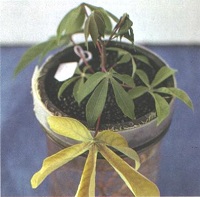
 |
|
 |
|||||||||||||||
P is a constituent of nucleic acid and is considered as the “energy currency” in plants. It has many physiological functions and involve in cell-enzymatic reactions. When the supply of P becomes inadequate, cell division slows down resulting in dwarfing of the plant. Since P plays a key role in processes like photosynthesis, phosphorylation, respiration, biosynthesis of proteins, carbohydrates etc, adequate P supply is essential for the synthesis of starch and for normal root production. P deficiency, being associated with the accumulation of carbohydrates, results in the production of dark green coloured leaves. Under conditions of continued deficiency, older leaves become bronzed or develop reddish purple tips and leaf margins. A deficiency of P can substantially reduce cassava growth with out any clear visible symptoms. The notable symptoms of acute P deficiency under field condition is the chlorosis that develops on the lower leaves and such leaves can not maintain their turgor; they hang down from the petioles and in severe cases, the stem becomes thinner, petioles shorter with narrow foliar lobes and fewer number of lobes than the normal leaves. Under severe P deficiency, plants develop dark yellow or orange coloured lower leaves, which later become necrotic and shed resulting in poor yields.
|
 |
|||||||||||||||